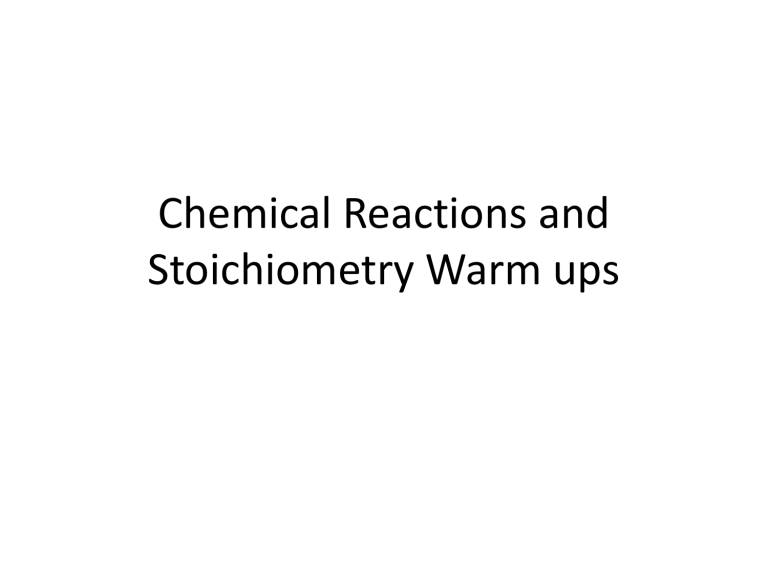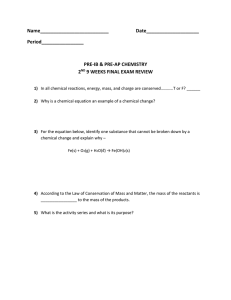Chemical Reactions and Stoichiometry Warm ups
advertisement

Chemical Reactions and Stoichiometry Warm ups 3/4 or 3/5 A solution of nickel (II) chloride is added to a solution of sodium sulfide. The products are solid nickel (II) sulfide and dissolved sodium chloride. 1. Write a chemical equation for this reaction. 2. Balance the chemical equation. 3. Identify the reaction type. 4. If I need to make 3 moles of sodium chloride, how many moles of nickel (II) chloride should I start with? 3/8 or 3/18 Oxygen gas is bubbled through a solution of potassium chloride to form dissolved potassium chlorate. 1. Write a complete, balanced equation. 2. What type of reaction is this? _________________ 3. How many moles of potassium chloride are needed to form 2.47 moles of potassium chlorate? 4. What changes indicate a chemical reaction? 3/19 or 3/20 1. On a note card, write at least one thing Ms. Kruth is doing well and at least one thing she should change/improve. – You do NOT have to put your name on the card. 2. Complete problem 1d (it’s really the second a) on page 11. Warm-up 3/21 or 3/22 In our lab, 1-3 drops of Silver Nitrate solution was added to a strip of Mg, producing solid Silver and Magnesium Nitrate solution 1. Write the balanced chemical equation, including state signifiers. 2. What type of reaction is this? 3. What are the mole ratios that can be formed from this balanced equation? 4. If I started with 4.28 moles of Ag, how many moles of Magnesium Nitrate can be produced? 5. What is meant by CdZnAgAl? 3/25 or 3/26 • Complete parts a-c for number 1 on page 12 in your packet. • If you finish that, continue working on parts ac on page 13. 3/25 or 3/26 Predict the products of the following reactions. Then balance the equations. 1. ___KOH + ___H2SO4 2. ___FeS + ___HCl 3. ___AgNO3 + ___NaCl What type of reaction were all of these? 3/27 or 3/28 • Check the answers to page 13 in your packet 2. a/b 3 F2(g) + 2 AlCl3(aq) 2 AlF3(aq) + 3 Cl2(g) c. Yes d. 0.0368 mol F2 3. a/b Mg(s) + Pb(C2H3O2)2(aq) Pb(s) + Mg(C2H3O2)2(aq) c. Yes d. 17.4 g Pb 4. a/b FeCl3(aq) + Pt(s) NR c. No d. N/A • After checking your answers, predict the products for the reactions written on the board. 4/1 or 4/2 Will these reactions occur? If so, predict the products: 1. __ZnCl2 + __Sn 2. __ZnCl2 + __K For these reactions, (1) predict the products, (2) determine (aq) or (s), then (3) will reaction occur? 3. __KI + __Na2CO3 4. __AgCl + __Na3PO4 5. For reaction #2, if 52.00 g of K is used, how many moles of Zn will be produced? Stoichiometry Practice Answers 1. 2. 3. 4. 5. 6. 7. 8. Coefficients 2, 1, 2 1, 2, 1, 2 2, 3, 2, 3 2, 1, 2 2, 2, 3 1, 2, 2, 1 Already balanced Already balanced 1. 2. 3. 4. 5. 6. 7. 8. Stoichiometry 2.82 26.4 91.6 186 1.67 0.129 17.5 175.9 4/5 or 4/8 1. Look over your Reactions & Stoichiometry Checkpoint (picked up on your way in) – Correct any wrong answers (with an explanation) to earn back 5 points each – Everyone (even if 100 ), turn it back in when finished 2. Turn in Stoichiometry Worksheet (if not its LATE) 3. Answer questions 1-4 on the bottom of page 6 in your packet (Limiting Reagents) 4. LAST, be sure you check your grades! 4/9 or 4/10 1. How many moles of H2O will be produced if 10.0 g of H2 reacts with 20.0 g of O2? __H2 + __O2 __H2O 2. Find your success rate, in percent, for the following situations a) You score a 12 out of 15 on a quiz b) You baked 29 cookies even though the recipe said it yielded 36 c) Your goal for a fundraiser was $1000, but you only raised $850 4/11 or 4/12 1. Determine the limiting reagent for copper when 1.87 grams of aluminum reacts with 9.65 grams of copper (II) sulfate. __Al + __CuSO4 → __Cu + __Al2(SO4)3 4/11 or 4/12 • Complete the Map of Mole Land problems on the final page of your packet. – For the first one, use moles to moles – For the second, use grams to moles – For the third, use grams to grams After the Test… • Pick up and work on the water worksheet (this is homework if you do not get it done in class)


